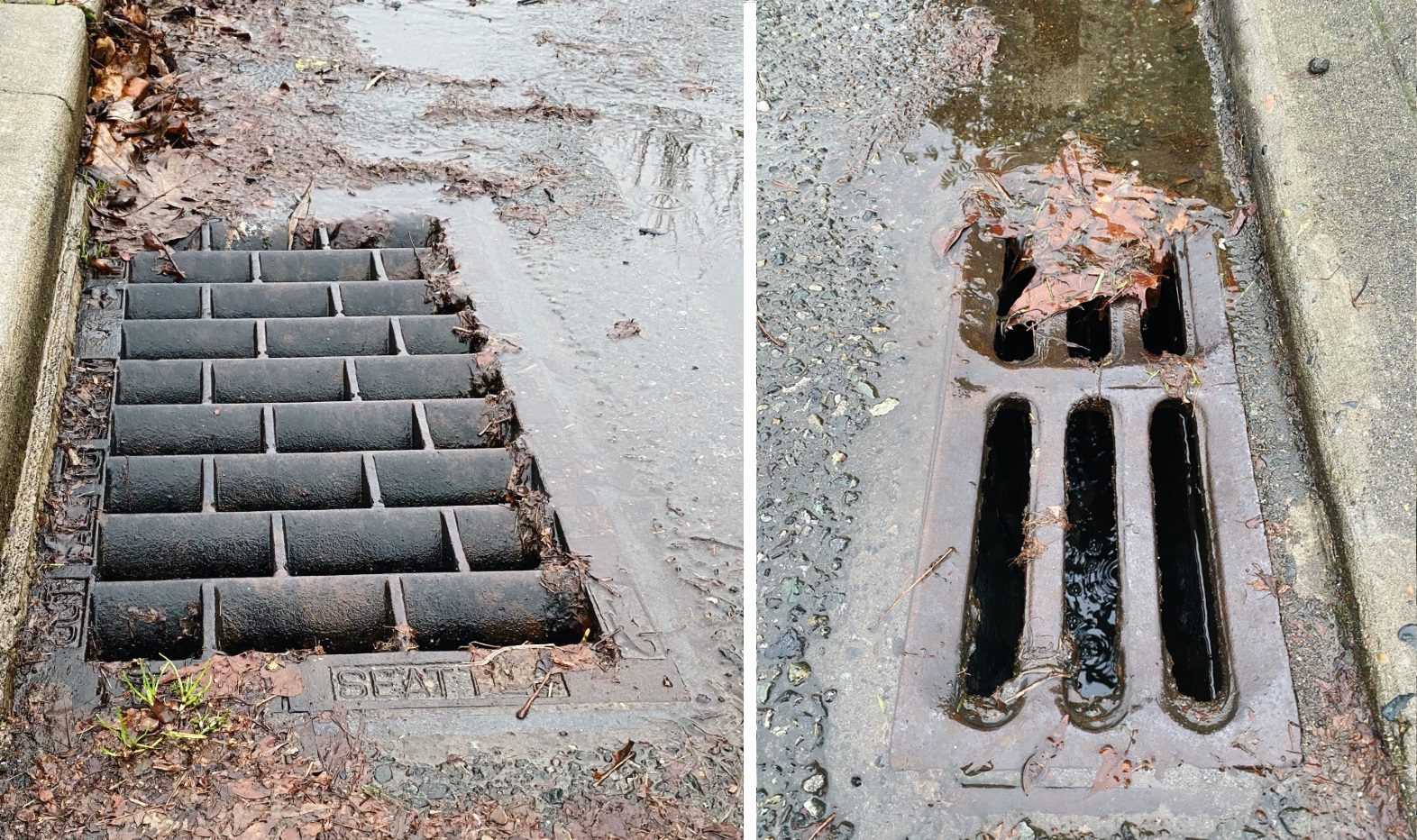 Clearing fall leaves from the sidewalk, a planting strip, and a curb area in Seattle. Photo credit: Jeanné Clark.
Clearing fall leaves from the sidewalk, a planting strip, and a curb area in Seattle. Photo credit: Jeanné Clark. Please note: this blog post is available in additional languages via the links below, including Amharic, Chinese, Korean, Somali, Spanish, Tagalog, and Vietnamese:
- ፀደይ እዚህ ነው፣ እና እኛ የእግረኛ መንገዶችን፣ የመትከያ ቁራጭ መሬቶችን እና የውሃ ፍሳሽ ቦዮችን ለመጥረግ እንዲረዳን ጠቃሚ አስታዋሾችን እያጋራን ነው!
- 秋天如期而至,我們正在分享重要的提示,以幫助保持人行道、綠化帶和排水溝通暢無阻!
- 가을이 왔습니다! 저희 시애틀 교통국(SDOT)에서는 보도, 보도 화단 및 배수구를 깨끗하게 유지하는 것을 돕기 위해 중요 상기 사항을 공유하고 있습니다.
- Dayrtii waa timid, waxaanan idin la wadaagaynaa xasuus muhiim ah si aan gacan uga geysanno nadiifinta waddooyinka lugta, xariijimaha beeridda, iyo mareennada!
- ¡El otoño está aquí y le queremos compartir importantes recordatorios para ayudar a mantener despejadas las aceras, las franjas para plantas y las canaletas!
- Ang taglagas ay nandito na, at kami ay magbabahagi ng mga importanteng paalala upang matulungan na mapantiling maaliwalas ang mga bangketa, hanay ng taniman, at alulod!
- Mùa thu đã đến, và chúng tôi muốn gửi đến quý vị những lời nhắc nhở quan trọng để giúp giữ cho vỉa hè, dải trồng cây, và rãnh thoát nước thông thoáng!
Summary:
- In autumn, we all need to do our part to keep sidewalks, planting strips, and gutters clear where we live or own a business.
- This is important because keeping sidewalks clear of fallen leaves and overgrown vegetation makes it easier for everyone to get around, and reduces slipping risks when the sidewalk gets wet or frozen.
- This blog post includes reminders and tips on how you can help ensure safe, reliable access for people walking and rolling in the city.
- You can also learn more about preparing for winter weather and possible snow and ice storms, and how you can be ready before they arrive.
Removing leaves keeps the sidewalk safe and accessible so that everyone can travel, particularly people who have accessibility needs or have a harder time getting around. It’s not only the right thing to do – it’s also the law. The area between your curb and property line, including sidewalks, planting strip areas, and vegetation, is your responsibility to maintain and keep in a state of good repair.

Here are some specific tips on what you can do to make sure people in your neighborhood are safe when they walk, roll, bike, or drive by. If you are unable to do these things, please consider asking someone to help you.
- Cut back vegetation adjacent to your property to a minimum of 8 feet above the sidewalk and 14 feet above the street. (Read more about tree pruning).
- Trim back vegetation that overhangs any portion of the sidewalk.
- Remove fallen leaves from the sidewalk.
- Remove moss and debris from the sidewalk.

Don’t forget about unblocking clogged gutters! If a drain is blocked and rainwater can’t drain properly, the area that people use to walk and roll can flood, particularly at the bottom of curb ramps. This makes the curb ramp difficult or impossible for people using manual wheelchairs to use. Remember, when you’re clearing leaves, please make sure that they don’t end up in the gutter. It’s best to put leaves in your green food and yard waste bins.

We encourage you to talk to your neighbors about what you can do together to keep your neighborhood safe for people walking and rolling. If you’re physically able to help your neighbors who can’t clear their sidewalks and nearby curb ramps, prune trees, or manage their vegetation in public areas – please consider checking on them and offering to help.
Learn more about sidewalk safety, tree pruning, maintenance, and more:
- If you have any questions, contact our customer service line by calling 206-684-ROAD (206-684-7623) or emailing 684-road@seattle.gov. Interpretation services are available for free!
- Read about tree pruning.
- Check your approximate property line.
- Learn the laws about sidewalk maintenance, duties of owners and occupants, and snow and ice removal.
Even though winter is not here yet, it’s important for everyone to get ready now for snow and icy winter weather conditions before they arrive.
We prepare for winter weather year-round. We work to keep the street clear of everything from fallen trees and branches to snow and ice, fix potholes so that streets are smooth, and repair signs and signals throughout the city. We also monitor conditions and ensure our crews are ready to go to work when high winds, heavy rain, or snow and ice are in the forecast.
We’re getting ready, and so should you! Here’s what you can do to prepare, and be ahead of the game before a storm hits:
- Get familiar with Seattle’s snow routes. These are the streets that we prioritize clearing, so they are the safest way to get where you need to go. Once it snows, use this online Winter Weather Response Map to see real-time updates of which streets we have plowed and live camera feeds of current street conditions.
- Talk to your neighbors to see who may need help with mobility during a storm and make a plan to ensure that all the sidewalks on the block get shoveled. If you’ll need help clearing your driveway and sidewalk, think about who you can ask for help.
- Stock up on warm clothes, extra blankets, and flashlights, before they’re in high demand.
- Get a snow shovel and bag of street salt to clear snow and ice.
- Make sure you have first aid kits and a three-day supply of food, water, and medicine.
Visit seattle.gov/transportation/winterweather for more information on winter weather. Additional resources regarding the City’s overall winter storm response are also available at seattle.gov/winterweather.